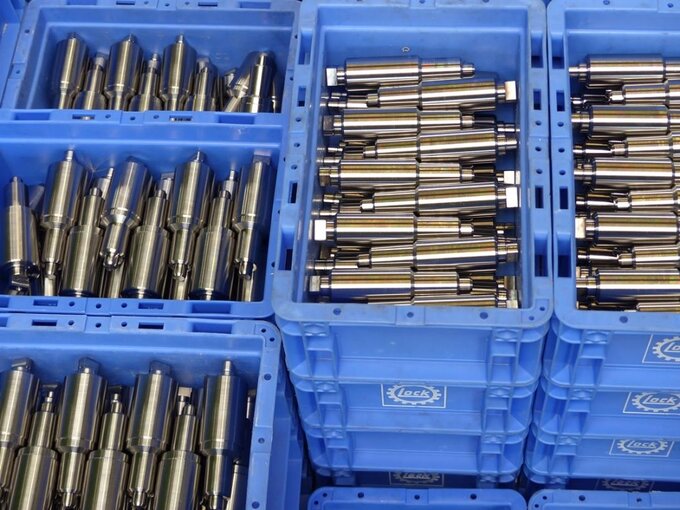
Why process monitoring is necessary with a robot on the machine!
Lock Antriebstechnik was able to almost quadruple its tool life with a tool and process monitoring system. Cost-intensive tool breakages due to enormous material fluctuations are now a thing of the past.
The company already had a whirling machine from Leistritz. Due to the consistently positive experience, Lock Antriebstechnik invested in another whirling machine from Leistritz, the LWN 120, in 2017. With this investment, the company wanted to combine the advantages of whirling, such as efficient dry machining and very high surface quality, with faster retooling and unmanned production (loading via robots) in the production of worms for gearboxes. This goal appeared to be achieved in the first stage. However, the tool plates repeatedly broke during the machining of certain modules. Tool life was reduced enormously at the time. Armin Schirmer, Head of Gearbox Parts Production at Lock Antriebstechnik, explains:
"On the one hand, breakage is caused by wear and tear. For us, however, it was mostly the tough and very different material." Armin Schirmer, Head of Gear Parts Production at Lock Antriebstechnik „The cutting edge becomes clogged and a built-up edge forms. The pressure then becomes too great and the insert breaks. That's why we tested coatings together with Leistritz, carried out material analyses, changed collets, tried all sorts of things, but came to no conclusion. Our assumption was that the material and cutting edge simply didn't fit together.“

Lock Antriebstechnik's speciality is a specific module with corresponding quantities. module with corresponding quantities. (Bild: UTTec)
An even bigger problem, however, was that if a mould broke, the machine components such as the spindle, axes, etc. were also displaced and had to be realigned. A cost-intensive measure. For this reason, Leistritz developed a system in which a measuring probe with its own axis saved a master profile in the control system, scanned the component and issued a corresponding message for further processing or cancellation. The problem was that a built-up edge is not regular wear. So the company in Ertingen decided to carry out measurements after a few screws and to change the mould plates early as a precaution. Although this resulted in a longer tool life, the problem of unmanned production and the enormous tool costs remained at night.
This is why Leistritz tested tool monitoring systems from the relevant manufacturers. For Patrick Schuka, Sales Manager Machine Tools at Leistritz, however, this was less satisfactory: "Many systems measured the current consumption, but when it came to breakage, it was too late. In other words, the systems were not sensitive enough and the results were not convincing. That's why we stopped these tests at some point, because we didn't want to pass the risk on to our customers." The collaboration with UTTec changed all that. After intensive trials with the Leistritz technology department, Uttec was convinced that these problems could not be solved with conventional standard monitoring systems. Numerous tests and analyses followed, with the realisation that increasing the cutting parameters leads to very fine, almost powder-like chips. For Uwe Schröter, Managing Director at UTTec, this was the starting point for further development:
"These results showed us where we needed to go with the analysis and sensitivity of the system. We then optimised our sensor technology once again, developed corresponding software and, on this basis, launched developments together with Leistritz that are proving successful today." Uwe Schröter, Managing Director at UTTec.

Patrick Schuka, Armin Schirmer, Jonas Zoll and Uwe Schröter (from left): "It is important that the system recognises early on when danger is imminent. With the quadrupling of tool life, fully automated production is no longer a problem."
The system was presented at Lock Antriebstechnik a year ago. In Ertingen, however, they were initially more than sceptical. According to Armin Schirmer, however, the scepticism was probably unfounded, as the system has now not only worked several times before a plate breakage, but has also already paid for itself by 70 percent. And what is particularly pleasing for Jonas Zoll, the machine operator, is that the system is relatively easy to understand: "Of course, you have to spend a certain amount of time with it until each programme fits a product series. You also have to make adjustments if other cutting parameters or tools are used. But it's really not difficult. Our speciality, for example, is a specific module with corresponding quantities. Once the system is set up, you can run it without any problems." Irrespective of this, the UTTm system includes wear monitoring. This can also be used to optimise the service life of the tool plates.
Although this has already been done in Ertingen, it is much more important for those responsible that the system recognises early on when danger is imminent. And because this is the case, Lock Antriebstechnik can now also realise what was planned when investing in the LWN 120: The machine starts with a pallet of workpieces shortly before the end of the shift and produces unmanned at night, and now also during the day. In addition, the service life of the tools has increased significantly, which naturally also results in a considerable reduction in tool costs.
Source: MM Maschinenmarkt, 20.11.2023, Manfred Lerch
Images: UTTec
Does this problem sound familiar to you? We have the solution! Please contact us.

Patrick Schuka
Head of Sales Machine Tools
Leistritz Produktionstechnik GmbH